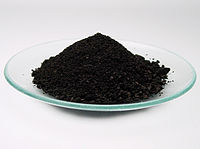
Photo from wikipedia
The effect of crystallizing solution chemistry on the chemistry of subsequently as-grown materials was investigated for Mo-substituted iron oxides prepared by thermally activated co-precipitation. In the presence of Mo ions,… Click to show full abstract
The effect of crystallizing solution chemistry on the chemistry of subsequently as-grown materials was investigated for Mo-substituted iron oxides prepared by thermally activated co-precipitation. In the presence of Mo ions, we find that varying the oxidation state of the iron precursor from Fe(II) to Fe(III) causes a progressive loss of atomic long-range order with the stabilization of 2-4 nm particles for the sample prepared with Fe(III). The oxidation state of the Fe precursor also affects the distribution of Fe and Mo cations within the spinel structure. Increasing the Fe precursor oxidation state gives decreased Fe-ion occupation and increased Mo-ion occupation of tetrahedral sites, as revealed by the extended X-ray absorption fine structure. The stabilization of Mo within tetrahedral sites appears to be unexpected, considering the octahedral preferred coordination number of Mo(VI). The analysis of the atomic structure of the sample prepared with Fe(III) indicates a local ordering of vacancies and that the occupation of tetrahedral sites by Mo induces a contraction of the interatomic distances within the polyhedra as compared to Fe atoms. Moreover, the occupancy of Mo into the thermodynamic site preference of a Mo dopant in Fe2O3 assessed by density functional theory calculations points to a stronger preference for Mo substitution at octahedral sites. Hence, we suggest that the synthetized compound is thermodynamically metastable, that is, kinetically trapped. Such a state is suggested to be a consequence of the tetrahedral site occupation by Mo ions. The population of these sites, known to be reactive sites enabling particle growth, is concomitant with the stabilization of very small particles. We confirmed our hypothesis by using a blank experiment without Mo ions, further supporting the impact of tetrahedral Mo ions on the growth of iron oxide nanoparticles. Our findings provide new insights into the relationships between the Fe-chemistry of the crystallizing solution and the structural features of the as-grown Mo-substituted Fe-oxide materials.
Journal Title: Inorganic chemistry
Year Published: 2021
Link to full text (if available)
Share on Social Media: Sign Up to like & get
recommendations!